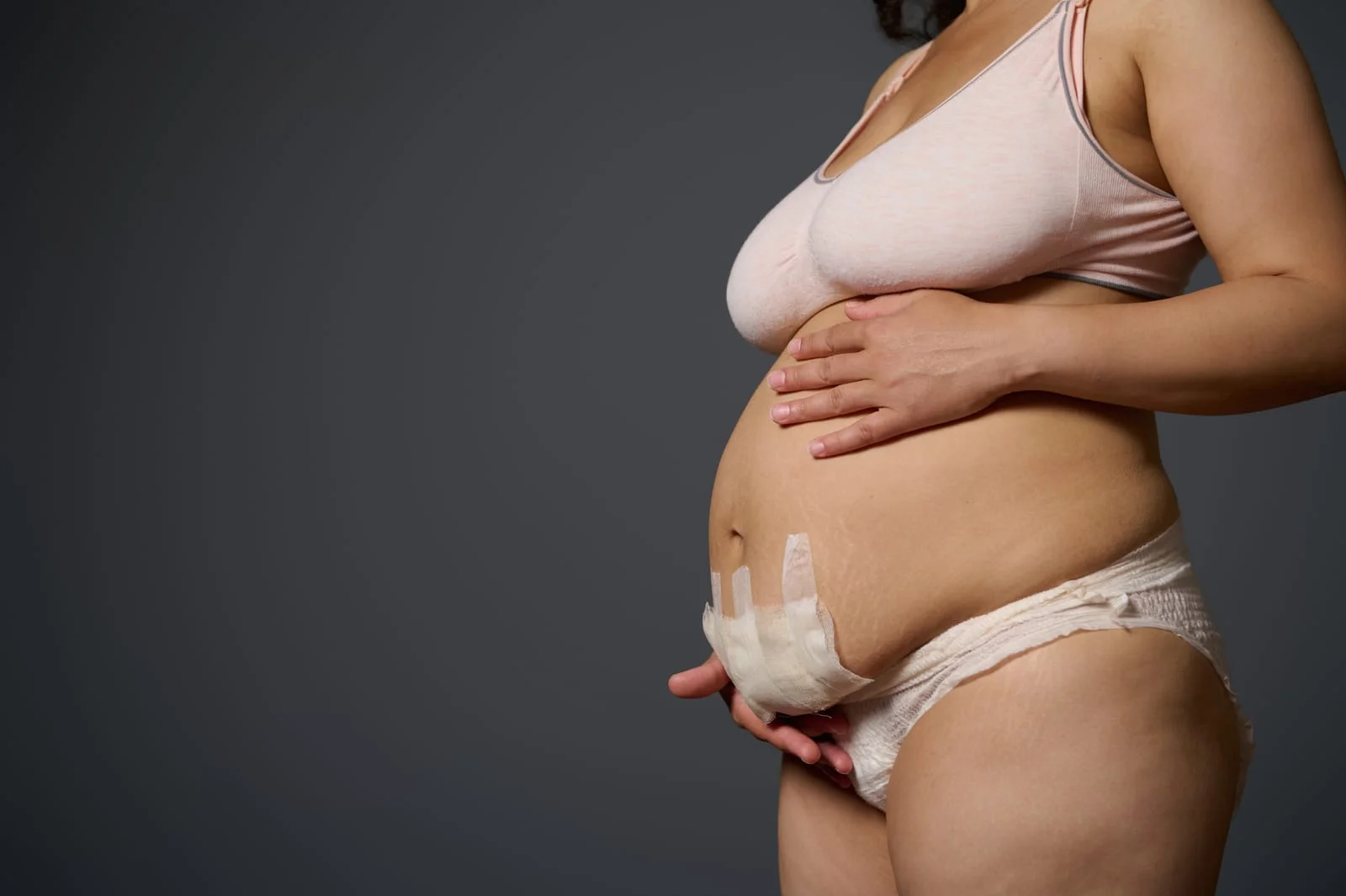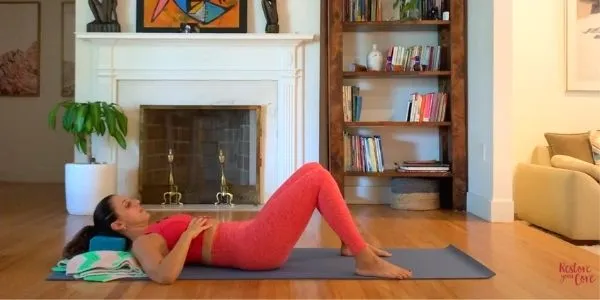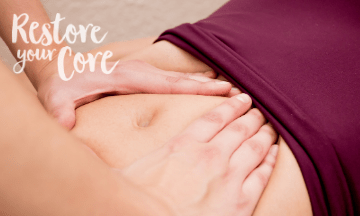
Lauren Ohayon is the creator of Restore Your Core® (RYC®), a comprehensive and sustainable whole-body fitness program that empowers women to achieve ideal pelvic floor / core function and be strong, long, mobile and functional.

Table of Contents
Pregnancy and delivery are a massive undertaking. Your body has to adapt and expand to allow the baby to grow, and having a C-section means you face a whole host of additional challenges, especially when it comes to recovery. Your body deserves some tender loving care to recover, and it can be tricky to know how to exercise after a c-section. We’ve created this article to guide you through a series of safe and effective core exercises tailored for post-C-section recovery, eliminating the guesswork.
In this article, we’ll delve into the importance of rebuilding strength and stability in your core and offer insights, tips, and a step-by-step guide to our five essential core exercises. These exercises are custom-made to tackle the unique hurdles of C-section recovery. We want to support you in your post-C-section recovery journey with our thoughtful and intentional approach.
Get free expert advice and start your postpartum healing journey today
Following a C-section, ensuring that you engage in exercises that are both safe and effective is vital for the healing process. A Cesarean section (C-section) is a major surgical procedure that leaves a lasting impact on your body, particularly on the abdominal muscles. The incision and healing process can influence the strength and function of your core. At RYC®, we know that understanding these effects is essential to crafting a tailored approach to C-section recovery.
In the initial postpartum period, when your body is healing, the emphasis needs to be on gentle, mindful exercises. Movements that help to gradually engage and strengthen the abdominal muscles without compromising the healing process. Taking a slow and steady approach is essential for a smooth recovery.
Before you start any core exercises post-Cesarean, it’s crucial to consider your individual recovery timeline, consult with your healthcare provider, and understand your body’s signals. By prioritizing your individual needs, your post-C-section fitness routine will be effective and, more importantly, safe.
Take 3 steps toward doing the things you love again postpartum
Rebuilding core strength after a C-section can be tricky, but when you take a considered and gradual approach, the results will come.
You must consult with your doctor and get clearance before starting any kind of workout program. We recommend the 5-5-5 step postpartum approach (5 days of rest, 5 days within reach of your bed, 5 days within a short distance from your bed) and also strongly recommend waiting until you are at least 8 weeks postpartum before attempting these exercises.
These 5 essential core exercises are designed to be a stepping stone back into exercise to start your post-C-section recovery. They will help you rebuild strength and resilience in your core muscles without pushing too hard. Remember, slow and steady wins this race, so stick to our short workouts until you feel strong enough to move on. Find out more about postpartum workout plans here.
These 5 exercises form the building blocks for your recovery and are designed to target and revitalize your core muscles, ensuring a safe and effective post-C-section recovery:
Discover the top 3 steps to regain your fitness and strength postpartum–free
Get 3 (free) scientifically-proven steps and regain your postpartum strength and fitness
Pelvic Tilt
Once comfortable, transition to the Glute Bridge.
Remember to start every movement with a candles exhale.
Try incorporating these exercises into your routine gradually, starting with a few repetitions and increasing as your strength improves. Always listen to your body and consult with your healthcare provider before beginning any post-C-section exercise regimen. Want more help with your postpartum recovery? Take a look at our 12-week program here.
Finding the right balance is crucial to a successful post-C-section recovery journey. Start by looking at your schedule and energy levels – be realistic. Aim for short, regular workouts, creating a routine you can commit to.
Consistency:
Consistency is the cornerstone of post-C-section recovery. Establish a routine that works for you, whether it’s a few minutes a day or longer sessions a few times a week. Consistent engagement with these exercises helps create muscle memory, slowly but surely building up that core strength.
Listening to Your Body:
Attune yourself to the signals your body sends. If you experience discomfort or strain during any exercise, change/modify or discontinue it. Pay attention to how your body responds to different movements, and make sure you prioritize comfort and gradual progress over pushing yourself too hard.
Progressively Increasing Intensity:
As your strength improves, it’s natural to want to challenge yourself more. Safely increase the intensity by adding repetitions or exploring advanced variations of the exercises. However, progress should be gradual to avoid overdoing it. Listen to your body’s cues and only do more when you feel ready. This gradual approach means you will have sustainable and injury-free progress in your post-C-section fitness journey.
Incorporating these exercises into your routine is a personal journey so feel free to tweak things based on how you’re feeling and your recovery. Always consult your healthcare provider before making significant changes to your exercise routine. Remember, the goal is not only to restore core strength and function, but to do so in a way that respects and supports your body throughout the entire post-C-section recovery process.
Besides the exercise workouts, think about including some gentle walks (no hiking just yet) and mindful stretches into your routine. Keep yourself hydrated, and make sure you are eating a nutrient-rich diet to support your overall healing process. Your recovery is unique, and there’s no one-size-fits-all approach. Embrace the pace that feels right for you.
Remember that you are laying the foundations here for more demanding and intense activities later in your recovery. A strong core supports you during daily activities, improves your posture and helps your resilience and confidence.
Embrace your journey with patience and self-compassion — please be kind to yourself! Celebrate every milestone along the way and understand that you are making amazing progress, however long it takes you. Remember you are healing from major abdominal surgery AND taking care of a tiny person — you’re doing a great job. By supporting your own recovery and prioritizing your healing, you’ll be back doing what you love before you know it.
If you are looking for a no-BS, helpful recovery program for your postpartum recovery, consider checking out our 12-week program here: made by women, for women.

The best core exercises after a C-section prioritize safety and effectiveness. Pelvic tilts, glute bridge, modified plank and heel slides are excellent choices. Ensure you consult with your healthcare provider before starting any new exercise routine.
It’s crucial to wait for your healthcare provider’s approval, usually around 8-10 weeks after a C-section. Initiate with gentle movements like pelvic tilts, gradually progressing as your body heals.
Yes, certain exercises like crunches and twists may strain the abdominal area. Focus on low-impact, controlled movements initially, and avoid exercises that cause discomfort or pain.
Yes, but it’s essential to proceed with caution and prioritize your body’s recovery. Start with gentle exercises and consult with your healthcare provider to ensure the safety of your post-C-section fitness routine.
Begin with 2 — 3 sessions per week, gradually increasing frequency as your strength improves. Consistency is key, but always listen to your body and avoid overdoing it.
Long-term benefits include improved posture, enhanced stability in daily activities, and a resilient core. Strengthening the core post-C-section contributes to overall well-being and supports your body in various physical endeavors.
Yes, certain core exercises can be modified to accommodate diastasis recti. Focus on movements that engage the transverse abdominis. Take a look at our diastasis recti page for more information here.
Yes, exercises like pelvic tilts and all exercises in our Restore Your Core® program contribute to pelvic floor strength. Exercises like Kegels should be avoided because they don’t take the whole body into consideration and often cause more harm than good.
Start with gentle movements, and pay attention to your body’s response. Check out our Restore Your Core® Facebook group for more tips and advice to ensure proper form and technique.
Absolutely! Combining core exercises with activities like gentle walks and stretches enhances overall recovery. Ensure a well-rounded approach that supports both your physical and mental well-being.

“There is no thank you big enough for Lauren Ohayon existing and thinking and helping so many of us. Every time I do something I never thought I’d do again she is part of the reason why.”
Laura Gregg
in this FREE video and get the support you deserve

Postpartum physical therapy can be a great way to restore function and strength in your core and pelvic floor muscles. Giving birth places a strain on your body and it...

The postpartum recovery period typically lasts well beyond common expectations. Guiding and supporting your postpartum patients and clients through this transitional period requires effective strategies tailored to their individual needs....

Postpartum recovery can be difficult for anyone, but there are particular considerations to keep in mind after a C-section. Read on to learn more about how to begin a safe...

Have you just had a baby, or are you about to give birth? Read on for pelvic floor exercises that facilitate faster postpartum recovery, enhance overall well-being, and improve long-term...

It is not uncommon for many postpartum people to experience complications such as pelvic organ prolapse postpartum. Vaginal and rectal prolapse occur when the supporting muscle and tissue structures become...

Giving birth takes a toll on your body – both physically and emotionally. Many postpartum people will feel overwhelmed and exhausted after giving birth, which can make it difficult to...

Before you begin any exercise routine, consult with your doctor for medical clearance. Practice patience with yourself and your body, and rest, lots of rest! I recommend waiting at least...

Post-pregnancy pain, whether it be pelvic floor pain or joint pain, is a shared experience among many postpartum people. However, postpartum pain, especially in pelvic pain, can vary in frequency,...

*No spam, just quality content and support
Please check your inbox soon.

Take 3 steps toward doing the things you love again postpartum
© 2025 RYC®. All rights reserved.
in this FREE video and get the support you deserve